Shenyi
Shenyi (Chinese: 深衣; Wade–Giles: Shên-i) (also known as "deep garment"[1][2] in English) literally means "wrapping the body deep within the clothes"[3] or "to wrap the body deep within cloth"[4]. It is the historical Chinese attire for men which is recorded in Book of Rites and advocated in Zhu Xi's Common Rites.[5] It has been the informal dress since Shang Dynasty. It was a form of informal wear for the scholar-official in Song Dynasty and Ming Dynasty. It was also introduced to Korea and Japan and exerted influences on Confucian clothing of Korea and Japan. Shenyi was introduced to Korea during Goryeo dynasty, and it was worn by followers of Confucianism.[6] The Shenyi Center of Chinese Medicine is named after it.
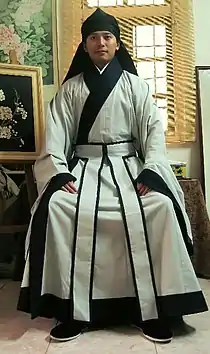
History and Earlier Development
The shenyi was the dominant form of Chinese dress worn from the Zhou dynasty to the Han dynasty.[7][8] The shenyi is a one-piece style which was first developed in the Warring States Period and was further developed into the Han Dynasty robe.[9]
At that period, the style of clothing was deeply rooted in the traditional Chinese ethics and morals which forbid close contacts between males and females.[10] In the Book of Rites, there is a special chapter which details the making of the shenyi,[11] the Book of Rites which stipulates that the shenyi is "one long robe; that it have broad sleeve openings; that its circumference at the waist be three times that of the sleeve-opening and that of its hem be even larger; that it have a youren opening; and so on".[12] The shenyi is also tied right below the waist with a silk ribbon, called dadai or shendai, on which a decorative piece can be attached to.[13] Twelve robes excavated from a Mashan tomb belonging to an anonymous lady who died sometime between 340-278 B.C. were all cut in the approximate style of shenyi whether they were padded with silk floss (mianpao), single in layer (danyi) or lined (jiayi).[14]
The shenyi grew in popularity during the transition from the Warring States period to the Former Han dynasty and its shape deviated further from its earlier description.[15] In the Han dynasty, the shenyi had wide sleeves and evolved into two types of robe: the qujupao (also known as "curved gown") and the zhijupao (also known as chan or yu or "straight gown" in English).[16] The qujupao (曲裾袍) was a long robe; its right front piece was cut as a triangular front piece that crossed in front of the body and has rounded under hem.[17][18] The qujupao would curve and wraps the dress to the back[19] and the contrasting or decorative edging of the robe would create a spiralling effect when encircling the body,[20] while the front opening of the Zhijupao (直裾袍) would fall straight down.[21] Although the Zhijupao was popular in the Han dynasty, it was not allowed to be worn as a ceremonial wear, for wearing outside of the house or for receiving guests at home.[22] Examples of shenyi worn in the Han dynasty can be seen in the archeological artefacts excavated from Mawangdui tomb in museums.[23][24][25] Of note, there have been gradual changes but clear distinctions in the form of the shenyi between the early and late period of the Western Han dynasty .[26] For example, the quju-style shenyi became nearly obsolete by the middle of the Western Han dynasty; and by the late Western Han dynasty, the garments were straight rather than spiralled.[27]
Design
Shenyi in later dynasties directly descended from the shenyi worn in earlier dynasties, like Han Dynasty. Shenyi originally is made of ramie cultivated in China. Ramie fabric needs to be bleached and produced 45 to 60 centimeters wide textile.
The yi (衣, blouse) and chang (裳, skirt) of the shenyi is sewn together. The upper part is made up of 4 panels of ramie fabric, representing four seasons of a year. 2 panels are fold and sewn to cover the upper body. Another 2 panels of ramie fabric are sewn onto each side of the yi as two sleeves. The lower part is made up of 12 panels of fabric sewn together (十二片縫合), representing 12 months a year. Its sleeves are wide with black cuff. A wide sash (大帶) is tied in the front.
 Structure of shenyi
Structure of shenyi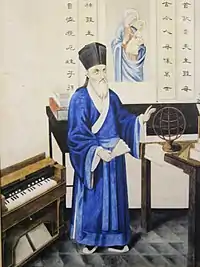
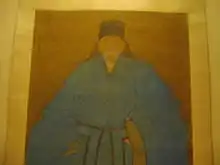
Drawings
 Confucian scholar Su Shi
Confucian scholar Su Shi Portrait of man wearing shenyi
Portrait of man wearing shenyi Korean Confucian scholar Seo Jik-su
Korean Confucian scholar Seo Jik-su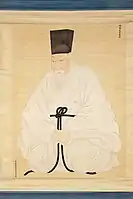 Korean Confucian scholar Yun Jeung
Korean Confucian scholar Yun Jeung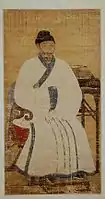 Korean Confucian scholar Yi Je-hyun
Korean Confucian scholar Yi Je-hyun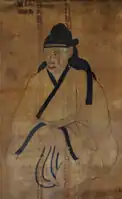 Korean Confucian scholar Song Siyeol
Korean Confucian scholar Song Siyeol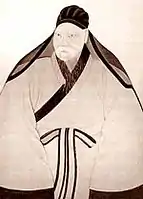 Korean Confucian scholar Park Ji-won
Korean Confucian scholar Park Ji-won Korean Confucian scholar Kwon Sang-ha
Korean Confucian scholar Kwon Sang-ha Korean Confucian scholar Heo Mok
Korean Confucian scholar Heo Mok Korean Confucian scholar Kim Jong-jik
Korean Confucian scholar Kim Jong-jik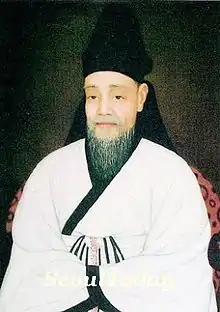 Korean Confucian scholar Han Seok-bong
Korean Confucian scholar Han Seok-bong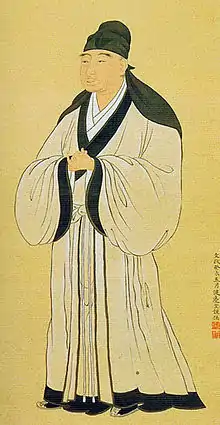 Japanese Confucian scholar Fujiwara Seika
Japanese Confucian scholar Fujiwara Seika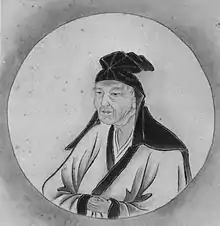 Edo Confucian scholar Hayashi Razan
Edo Confucian scholar Hayashi Razan
See also
References
- Hua, Mei (2004). Chinese Clothing (1 ed.). Beijing: China International Press. pp. 9–14. ISBN 7-5085-0540-9.
- Lynch, Annette; Strauss, Mitchel D. (2014). Ethnic dress in the United States : a cultural encyclopedia. Lanham, Maryland: Rowman & Littlefield Publishers. pp. 135–136. ISBN 9780759121508. Retrieved 3 February 2021.
- Hua, Mei (2004). Chinese Clothing (1 ed.). Beijing: China International Press. pp. 9–14. ISBN 7-5085-0540-9.
- Lynch, Annette; Strauss, Mitchel D. (2014). Ethnic dress in the United States : a cultural encyclopedia. Lanham, Maryland: Rowman & Littlefield Publishers. pp. 135–136. ISBN 9780759121508. Retrieved 3 February 2021.
- 《朱子家禮》
- http://encykorea.aks.ac.kr/Contents/SearchNavi?keyword=%EC%8B%AC%EC%9D%98&ridx=1&tot=106. Missing or empty
|title=(help) - Hunan Museum. "Plain Gauze Gown". Hunan Museum. Retrieved 3 February 2021.
- Zhang, Qizhi (2015). An introduction to Chinese history and culture. Heidelberg: Springer, Berlin, Heidelberg. pp. 255–261. ISBN 978-3-662-46482-3.
- Hua, Mei (2004). Chinese Clothing (1 ed.). Beijing: China International Press. pp. 9–14. ISBN 7-5085-0540-9.
- Hua, Mei (2004). Chinese Clothing (1 ed.). Beijing: China International Press. pp. 9–14. ISBN 7-5085-0540-9.
- Hua, Mei (2004). Chinese Clothing (1 ed.). Beijing: China International Press. pp. 9–14. ISBN 7-5085-0540-9.
- Sheng, Angela (1995). "The Disappearance of Silk Weaves with Weft Effects in Early China". Chinese Science (12): 41–76. ISSN 0361-9001. Retrieved 3 February 2021.
- Hua, Mei (2004). Chinese Clothing (1 ed.). Beijing: China International Press. pp. 9–14. ISBN 7-5085-0540-9.
- Sheng, Angela (1995). "The Disappearance of Silk Weaves with Weft Effects in Early China". Chinese Science (12): 41–76. ISSN 0361-9001. Retrieved 3 February 2021.
- Sheng, Angela (1995). "The Disappearance of Silk Weaves with Weft Effects in Early China". Chinese Science (12): 41–76. ISSN 0361-9001. Retrieved 3 February 2021.
- Hua, Mei (2004). Chinese Clothing (1 ed.). Beijing: China International Press. pp. 9–14. ISBN 7-5085-0540-9.
- Hua, Mei (2004). Chinese Clothing (1 ed.). Beijing: China International Press. pp. 9–14. ISBN 7-5085-0540-9.
- Lullo, Sheri A. (September 2019). "Trailing Locks and Flowing Robes: Dimensions of Beauty during China's Han dynasty (206 bc – ad 220)". Costume. 53 (2): 231–255. doi:10.3366/cost.2019.0122. Retrieved 3 February 2021.
- Sheng, Angela (1995). "The Disappearance of Silk Weaves with Weft Effects in Early China". Chinese Science (12): 41–76. ISSN 0361-9001. Retrieved 3 February 2021.
- Lullo, Sheri A. (September 2019). "Trailing Locks and Flowing Robes: Dimensions of Beauty during China's Han dynasty (206 bc – ad 220)". Costume. 53 (2): 231–255. doi:10.3366/cost.2019.0122. Retrieved 3 February 2021.
- Sheng, Angela (1995). "The Disappearance of Silk Weaves with Weft Effects in Early China". Chinese Science (12): 41–76. ISSN 0361-9001. Retrieved 3 February 2021.
- Hua, Mei (2004). Chinese Clothing (1 ed.). Beijing: China International Press. pp. 9–14. ISBN 7-5085-0540-9.
- Hunan Museum. "Plain Gauze Gown". Hunan Museum. Retrieved 3 February 2021.
- Hong Kong Heritage Museum. "Images of Females in Chinese History: Thematic Gallery". Hong Kong Heritage Museum. Retrieved 3 February 2021.
- Zhang, Qizhi (2015). An introduction to Chinese history and culture. Heidelberg: Springer, Berlin, Heidelberg. pp. 255–261. ISBN 978-3-662-46482-3.
- Lullo, Sheri A. (September 2019). "Trailing Locks and Flowing Robes: Dimensions of Beauty during China's Han dynasty (206 bc – ad 220)". Costume. 53 (2): 231–255. doi:10.3366/cost.2019.0122. Retrieved 3 February 2021.
- Lullo, Sheri A. (September 2019). "Trailing Locks and Flowing Robes: Dimensions of Beauty during China's Han dynasty (206 bc – ad 220)". Costume. 53 (2): 231–255. doi:10.3366/cost.2019.0122. Retrieved 3 February 2021.
